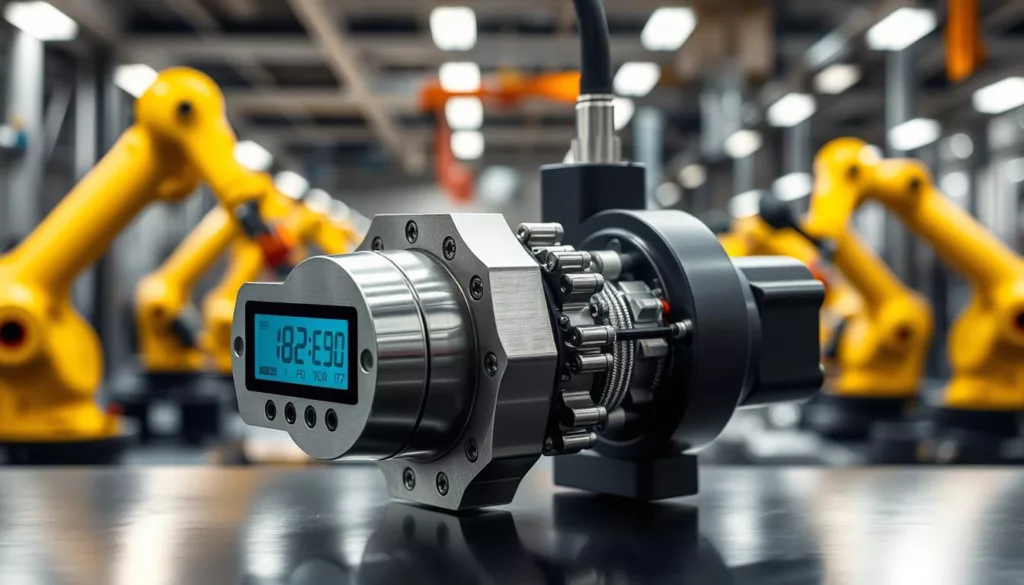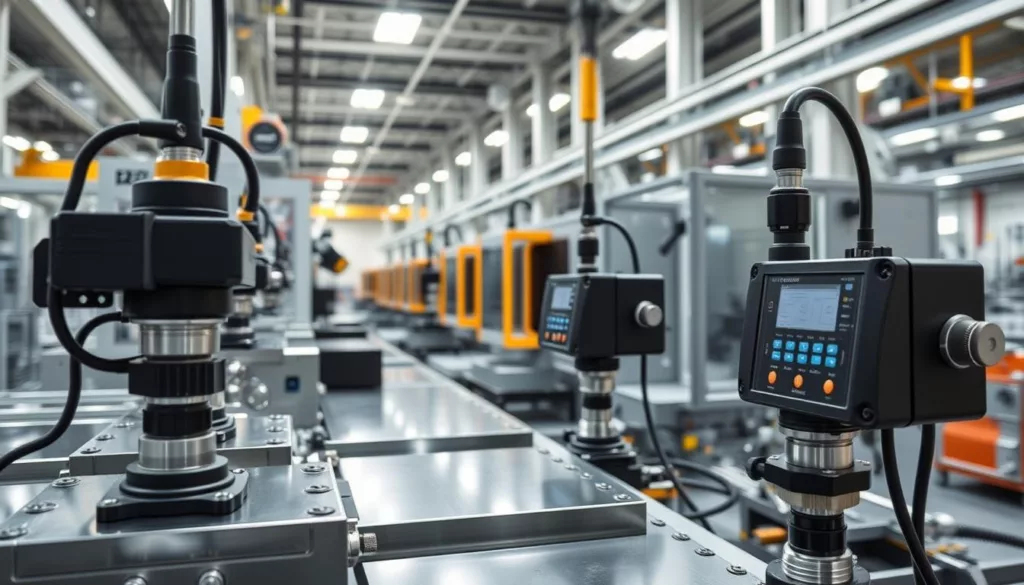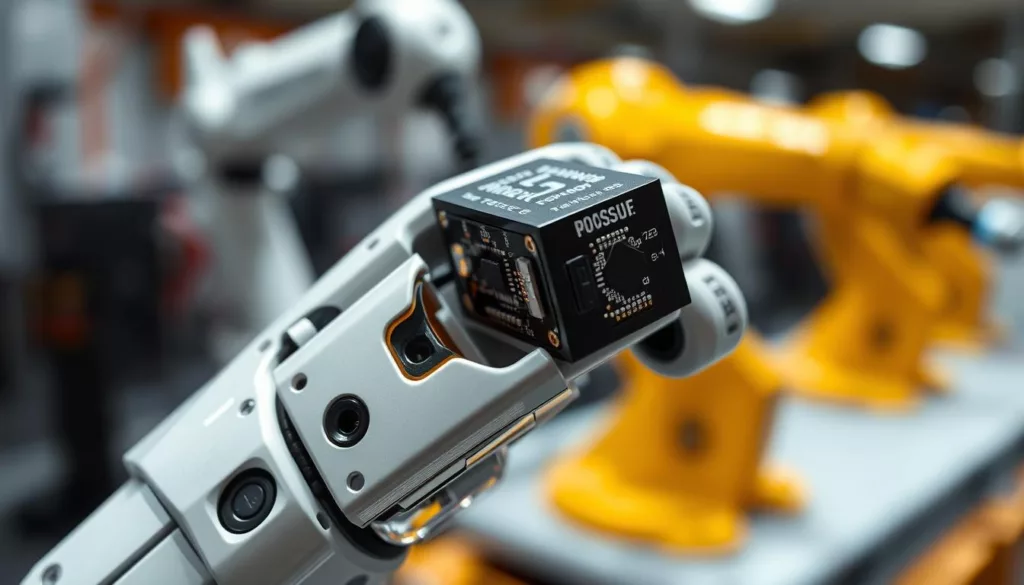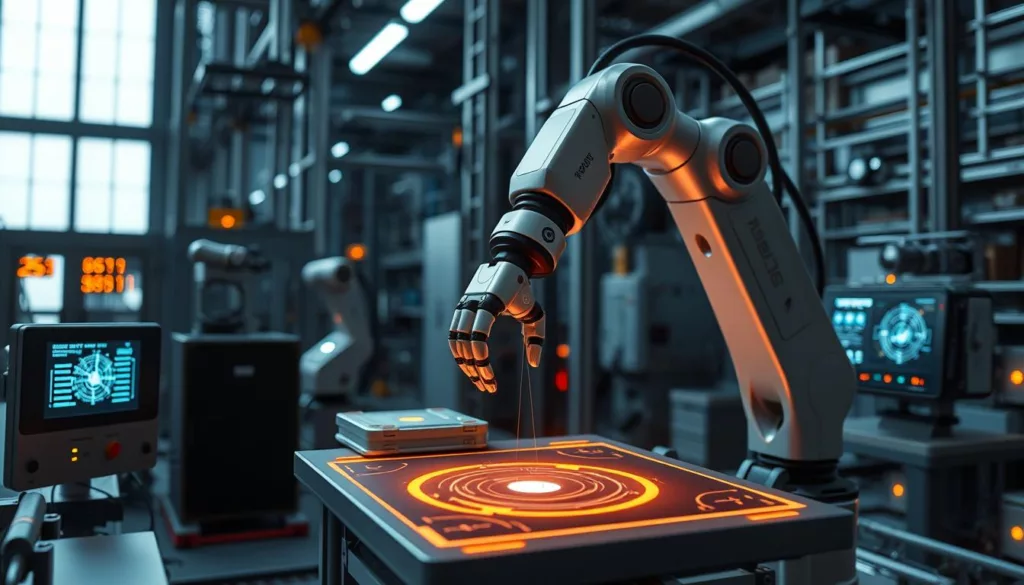The world of industrial automation is moving fast, and so is the need for precise force and torque sensors. At XJCSENSOR, we’re proud to offer top-notch sensing solutions made in the United States. Our sensors are made for high accuracy and reliability, perfect for robots, manufacturing, and testing.
Accuracy and precision are key for automation success. Our sensors meet the highest standards. They use the latest in material science and engineering for consistent, high-quality measurements. This is vital for efficient, cost-effective, and safe industrial work.
Key Takeaways
- XJCSENSOR’s precision force and torque sensors are designed and manufactured in the USA.
- Our sensors are engineered to deliver unparalleled accuracy and reliability for industrial automation applications.
- Consistent, high-quality measurements are essential for efficient, cost-effective, and safe industrial operations.
- XJCSENSOR’s sensors are built to exceed the most stringent industry standards.
- Leveraging the latest advancements in material science and engineering, our sensors provide the precision required for successful automation processes.
Understanding Force and Torque Sensing Technology
In the world of automation and industrial processes, knowing the exact amount of force and torque is key. This ensures everything works well, efficiently, and safely. Force sensors and torque sensors are essential. They measure forces like tension and twisting forces in many areas, from robots to quality checks.
Basic Principles of Force Measurement
Force measurement relies on strain gauges and force sensing resistors. These technologies turn mechanical force into an electrical signal. This lets us get accurate and reliable data. Knowing how these sensors work helps engineers pick the right one for their needs.
Types of Torque Detection Methods
Torque sensing uses strain gauge technology to measure twisting forces. There are also special torque sensors, like Hall effect or optical ones. These offer high precision, fast response, and can work well in tough environments.
Sensor Calibration Fundamentals
Sensor calibration is vital for accurate force and torque measurements. It adjusts the sensor’s output to match known values. This ensures the data is correct. Keeping sensors calibrated and maintained is key for their long-term reliability.
| Sensor Type | Measurement Principle | Key Applications |
|---|---|---|
| Force Sensing Resistor | Change in electrical resistance proportional to applied force | Robotics, human-machine interfaces, industrial process control |
| Strain Gauge | Change in electrical resistance due to deformation of the sensor material | Load cells, torque sensors, structural monitoring |
| Hall Effect Torque Sensor | Measurement of magnetic field changes due to the twisting of a shaft | Automotive, industrial machinery, power tools |
Understanding force and torque sensing helps engineers choose the right sensors. This improves system performance, reliability, and safety.
Precision Force and Torque Sensor for Automation: A Complete Guide
Precision force and torque sensors are key in modern industrial automation. They ensure optimal performance, efficiency, and safety. This guide will help you understand and integrate these advanced sensing solutions into your systems.
These sensors accurately measure forces and rotational forces. They provide real-time data for fine-tuned control in various industrial applications.
Sensor Selection Criteria
Choosing the right precision force and torque sensor is important. Consider several factors:
- Measurement range and sensitivity
- Accuracy and repeatability
- Environmental durability and resistance
- Communication protocols and integration compatibility
- Power requirements and energy efficiency
Integration Considerations
Integrating these sensors into your systems requires careful planning. Key aspects include:
- Sensor placement and mounting
- Wiring and connectivity
- Calibration and configuration
- Data processing and visualization
- Maintenance and troubleshooting
Best Practices for Industrial Applications
To ensure top performance, follow industry-accepted best practices. These include:
| Best Practice | Description |
|---|---|
| Environmental Considerations | Select sensors with the right IP ratings and resistance to temperature, vibration, and chemicals. |
| Sensor Calibration | Regular calibration to keep accuracy and consistency in your processes. |
| Data Integration | Integrate sensor data smoothly with your control systems and analytics platforms. |
Understanding precision force and torque sensors’ capabilities and best practices can enhance your automation. This leads to more efficient and high-performing industrial operations.
“Precision force and torque sensors are the unsung heroes of modern industrial automation, quietly ensuring the smooth and efficient operation of our most complex manufacturing systems.”
Applications in Modern Manufacturing Systems
Advanced manufacturing is changing the way we make things. Precision force and torque sensors are key to this change. They help in robotic assembly, quality control, and testing, making things more efficient and accurate.
Robotic Assembly Lines
In robotic assembly, XJCSENSOR’s force sensing solutions are essential. They help robots work together smoothly and precisely. This leads to better speed and efficiency in making things.
Quality Control Processes
Force and torque sensors from XJCSENSOR are great for quality control. They help check if products are up to standard. They can spot small problems and check how much force is needed for assembly.
Automated Testing Equipment
XJCSENSOR’s sensors also improve automated testing. They give real-time info on materials and how they handle stress. This makes testing more thorough and reliable, without needing people to do it.
These sensors are making manufacturing better in many ways. They help make things faster, more accurate, and of higher quality. By using these technologies, companies can do better and stay ahead in a changing world.
| Application | Benefit | Key Capabilities |
|---|---|---|
| Robotic Assembly Lines | Improved accuracy and efficiency | Precise component placement, part alignment, and force management |
| Quality Control Processes | Enhanced product integrity | Detecting deformities, measuring assembly forces |
| Automated Testing Equipment | Reliable product validation | Real-time data on material properties, stress points, and load-bearing capacities |
XJCSENSOR’s Advanced Sensing Solutions
At XJCSENSOR, we focus on top-notch industrial sensors for today’s manufacturing needs. Our solutions offer unmatched precision, reliability, and flexibility. They help our customers improve their automation processes.
We’re proud to be a leading XJCSENSOR provider. We customize our industrial sensors to solve our clients’ unique problems. Our skilled engineering team works with each customer to meet their needs. This ensures our advanced sensing solutions fit perfectly into their systems.
Our range includes advanced force and torque sensors and innovative tactile feedback systems. These products boost productivity, quality, and safety in many industries. We’re always researching and developing to improve sensor technology. This keeps us at the forefront of industrial automation.
Quality and customer satisfaction are our top priorities. All our sensors are manufactured in the USA. This guarantees the highest quality and reliability. By choosing XJCSENSOR, our clients get advanced sensing solutions that improve their performance and market position.
“XJCSENSOR’s sensors have been a game-changer for our automated assembly lines. The precision and reliability of their products have helped us achieve unprecedented quality and efficiency in our manufacturing processes.”
Integration of Force Sensing Resistors in Industrial Automation
The world of industry is always changing. New technologies like force sensing resistors (FSRs) are key in modern automation. These sensors help make industrial processes more precise, efficient, and safe.
Installation Best Practices
Installing force sensing resistors right is key for their best performance and life in industrial settings. Here’s how to do it:
- Choose the right FSR model for your needs, like force range and sensitivity.
- Place the sensor where it can get the force or pressure data you need.
- Mount the FSR securely to avoid any movement during use.
- Connect the sensor to your automation system’s control and data setup.
- Calibrate the FSR as the maker suggests to get accurate readings.
Maintenance Requirements
Keeping force sensing resistors in good shape is vital for their performance. Here’s what to do:
- Check the FSR for damage or wear and fix it fast.
- Clean the sensor to stop dirt from messing with its sensitivity.
- Check and adjust the sensor’s calibration as needed.
- Make sure the electrical connections are tight and clean.
Troubleshooting Guidelines
If you run into problems with your force sensing resistors, follow these steps:
- Look at the sensor’s mounting and connections to see if they’re okay.
- Check if the sensor’s calibration is right and adjust it if needed.
- Check the automation system’s software for any mistakes or issues.
- Get help from the maker’s support team if you’re stuck.
By sticking to these guidelines, you can keep your force sensing resistors working well. This makes your automation systems more efficient and effective.
Enhancing Robotic Gripper Performance with Tactile Sensors
In modern manufacturing, tactile sensors in robotic grippers are a big leap forward. They not only help with better grip control but also make handling and assembly more efficient.
Tactile sensors work like our sense of touch. They let robotic grippers feel force, pressure, and texture. This means robots can now handle delicate and odd-shaped objects more carefully. It also cuts down on damage and boosts product quality.
Key Benefits of Tactile Sensors in Robotic Grippers
- Improved grip control and stability, allowing for gentle handling of fragile components
- Enhanced object recognition and localization, enabling more accurate positioning and manipulation
- Haptic feedback for improved human-robot collaboration and teleoperation
- Increased efficiency and productivity in automated assembly and packaging processes
| Feature | Benefit |
|---|---|
| Tactile Sensing | Precise control of gripping force and object detection |
| Robotic Gripper | Enhanced dexterity and adaptability for handling diverse objects |
| Haptic Feedback | Improved human-robot interaction and teleoperation capabilities |
Adding tactile sensors to robotic grippers brings new levels of automation, precision, and efficiency. This drives innovation and keeps manufacturers competitive.
“Tactile sensors are revolutionizing the way robotic grippers interact with their environment, opening up a world of new possibilities in automated manufacturing.”
Load Cell Technology and Strain Gauge Applications
In the world of industrial automation, load cells and strain gauges are key. They measure force, weight, and torque with great precision. These sensors are vital in many critical applications, like robotic assembly and quality control. Knowing how load cells and strain gauges work is key to making your systems better and more reliable.
Load Cell Selection Criteria
Choosing the right load cell involves several important factors. You need to think about the capacity range, accuracy, environment, and mounting needs. By carefully considering these, you can pick a load cell that gives you the exact measurements you need for your automation projects.
Performance Optimization Tips
- Proper load cell installation and calibration to minimize measurement errors
- Regular maintenance and inspection to maintain optimal performance
- Integration of signal conditioning and data processing electronics for enhanced data analysis
Data Analysis Methods
The data from load cells and strain gauges is very valuable. It can give you deep insights into your automated processes. By using advanced data analysis, like statistical process control and predictive analytics, you can spot trends, find anomalies, and improve system performance. This leads to better efficiency and productivity.
| Load Cell Specification | Example Value |
|---|---|
| Capacity Range | 0 – 5,000 lbs |
| Accuracy | ±0.03% of Full Scale |
| Excitation Voltage | 10 VDC |
| Output Signal | 2 mV/V |
“Leveraging the power of load cell technology and strain gauge applications is essential for achieving precise, reliable, and data-driven automation in modern manufacturing.” – Automation Engineer, XJCSENSOR
Haptic Feedback Systems in Automated Operations
In the world of industrial automation, haptic feedback systems have changed how we work with machines. These new technologies, with force and torque sensors, make control, safety, and work better in many areas.
Haptic feedback, a way of tactile sensing, lets operators feel what’s happening with the machines. It sends real-time data about force and torque to the user. This makes controlling machines easier and faster, helping operators make better choices.
- Improved Precision and Control: Haptic feedback systems help operators control force and torque well. This means delicate tasks are done carefully and accurately.
- Enhanced Safety: These systems give operators cues about possible dangers. This helps avoid accidents and damage to machines.
- Increased Productivity: Haptic feedback and automated operations work together smoothly. This leads to better workflows, fewer mistakes, and more efficiency.
| Application | Benefits of Haptic Feedback |
|---|---|
| Robotic Assembly | Precise control over delicate components, reduced risk of damage |
| Quality Inspection | Enhanced detection of defects, improved product quality |
| Automated Testing | Improved consistency and repeatability of test procedures |
As we need more advanced automation, haptic feedback systems will be key. They help make automated operations better, leading to more efficiency and precision.
“Haptic feedback systems are redefining the way we interact with automated machinery, empowering operators to achieve unprecedented levels of control and responsiveness.”
Quality Control and Validation Processes
At XJCSENSOR, we aim to provide top-notch precision force and torque sensors for our clients. We follow strict quality control and validation steps. This ensures every sensor meets the highest industry standards. Let’s dive into what makes our quality assurance stand out.
Testing Protocols
Our sensors go through a detailed test series to check their performance and reliability. We do quality control tests like static and dynamic force and torque checks. Our team also evaluates sensor linearity and repeatability.
Experts follow strict sensor testing protocols. They check each sensor’s accuracy, sensitivity, and durability.
Certification Standards
XJCSENSOR’s sensors meet or exceed top certification standards in the field. We test our products against leading industry benchmarks. This ensures they follow all regulations and specifications.
This focus on quality is shown in the certifications our sensors have. It gives our customers confidence in our products.
Documentation Requirements
- Detailed test reports documenting the performance parameters of each sensor
- Comprehensive calibration records to ensure traceability and repeatability
- Thorough inspection checklists verifying compliance with design specifications
- Quality control certifications and compliance documentation
We keep detailed records to show our customers the quality of our products. This ensures they know their XJCSENSOR products are thoroughly tested. Our focus on detail helps us deliver reliable, high-performance solutions for modern automation systems.
Conclusion
Precision force and torque sensors are key in industrial automation. XJCSENSOR, a top force sensor manufacturer, offers high-quality solutions. These solutions meet the varied needs of today’s manufacturing.
XJCSENSOR’s advanced sensing technologies have changed how industries automate. Their work in robotic assembly, quality control, and testing equipment is groundbreaking. They use force and torque measurement and sensor calibration to boost precision and efficiency.
The need for smart, connected automation is rising. XJCSENSOR leads in innovation, providing custom force transducers and solutions. They are dedicated to technical excellence and innovation, making them a reliable partner for industrial success.





